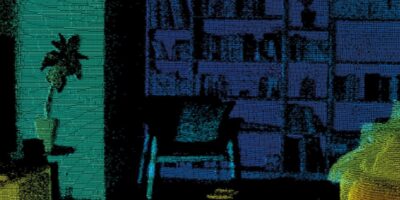0.5Mpixel depth sensor brings 3D depth imaging to mobile devices
The VD55H1 is the first member of a family of high-resolution time-of-flight sensors by STMicroelectronics. According to the company, it brings advanced 3D depth imaging to smartphones and other devices.
The sensor maps three-dimensional surfaces by measuring the distance to over half a million points. Objects can be detected up to 5m from the sensor, and even further with patterned illumination. These parameters mean the VD55H1 addresses emerging AR/VR use cases, including room mapping, gaming and 3D avatars.
In smartphones, the sensor enhances the performance of camera-system features including Bokeh effect, multi-camera selection and video segmentation. Higher resolution also improves face-authentication security, together with more accurate 3D images to protect phone unlocking, mobile payment and any smart system involving secure transactions and access control.
The VD55H1 operates with a modulation frequency of 200MHz with more than 85 per cent demodulation contrast at 940nm. This reduces the depth noise by a factor of two over incumbent sensors that typically operate around 100MHz. In addition, multi-frequency operation, a depth-unwrapping algorithm, low pixel noise floor and high pixel dynamic range ensure superior measurement accuracy over long ranging distance, claimed ST. Depth accuracy is better than one per cent and typical precision is 0.1 per cent of distance.
Other features include a short capture sequence that supports a frame rate up to 120 frames per second and improves motion-blur robustness. Clock and phase management, including spread spectrum clock generator (SSCG), provides multi-device interference mitigation and optimised electromagnetic compatibility (EMC).
The power consumption can be reduced to less than 100mW in some streaming modes, to help prolong the runtime of battery-operated devices, advised ST.
The addition of the VD55H1 3D depth sensor expands the company’s FlightSense products. “The FlightSense portfolio now comprises direct and indirect ToF products from single-point ranging all-in-one sensors to sophisticated high-resolution 3D imagers enabling future generations of intuitive, smart, and autonomous devices,” said Eric Aussedat, ST’s executive vice president, imaging sub-group general manager
VD55H1’s pixel architecture and fabrication process, leveraging in-house 40nm stacked wafer technology, ensures low power consumption, low noise, and optimised die area, confirmed ST. The die contains 75 per cent more pixels than existing VGA sensors, within a smaller die size.
The VD55H1 sensor has a 672 x 804 back-side illuminated (BSI) pixel array for iToF depth sensing. It is now available for lead customers to sample. Volume production maturity is scheduled for the second half of 2022.
A consumer device form factor reference design for the VD55H1 has been created that includes the illumination system. A supporting fully featured software driver and a library containing an advanced depth-reconstruction image-signal-processing pipeline compatible with Android embedded platforms is also provided.




